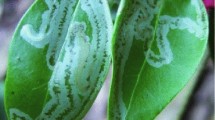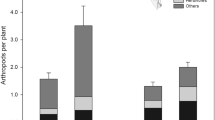Abstract
We experimentally examined the effects on other herbivorous insects of leaf shelters constructed by lepidopteran larvae on a willow, Salix miyabeana. Several insect species occupied the vacant leaf shelters. Our experiment using artificial leaf shelters showed that the number of aphids increased with the number of artificial leaf shelters on a shoot, as did the numbers of three ant species (Camponotus japonicus, Lasius hayashi, and Myrmica jessensis) that entered leaf shelters to collect aphid honeydew. To determine the ant-mediated effect of leaf shelters on herbivorous insects that do not use leaf shelters, we transferred newly hatched larvae of a common leaf beetle, Plagiodera versicolora, to the leaves of shoots with and without artificial leaf shelters. One day after the transfer, larval survival rate was significantly lower on shoots with shelters than on those without shelters, and shoots with shelters had significantly more ants than did shoots without shelters. Our field experiments demonstrated clearly that shelter-making lepidopteran larvae increased the abundance of both aphids and ants and decreased the survival rate of leaf beetle larvae, probably because the larvae were removed by ants that were attracted to the leaf shelters by the aphid colonies.




Similar content being viewed by others
References
Akimoto S (1981) Gall formation by Eriosoma fundatrices and gall parasitism in Eriosoma yangi (Homoptera, Pemphigidae). Kontyu 49:426–436
Alper J (1998) Ecosystem engineers shape habitats for other species. Science 280:1195–1196
Atlegrim O (1989) Exclusion of birds from bilberry stands: impact on insect larval density and damage to the bilberry. Oecologia 79:136–139
Buckley RC (1987) Interactions involving plants, homoptera, and ants. Annu Rev Ecol Syst 18:111–135
Cappuccino N (1993) Mutual use of leaf-shelters by lepidoperan larvae on paper birch. Ecol Entomol 18:287–292
Cappuccino N, Martin M (1994) Eliminating early-season leaf-tiers of paper birch reduces abundance of mid-summer species. Ecol Entomol 19:399–401
Carroll CR, Janzen DH (1973) Ecology of foraging by ants. Annu Rev Ecol Syst 4:231–257
Carroll MR, Kearby WH (1978) Microlepidopterous oak leaftiers (Lepidoptera: Gelechioidea) in central Missouri. J Kans Entomol Soc 51:457–471
Carroll MR, Wooster MT, Kearby WH, Allen DC (1979) Biological observations on three oak leaftiers: Psilocorsis quercicella, P. reflexella and P. cryptolechiella in Massachusetts and Missouri. Ann Entomol Soc Am 72:441–447
Damman H (1987) Leaf quality and enemy avoidance by the larvae of a pyralid moth. Ecology 68:88–97
Damman H (1993) Patterns of interaction among herbivore species. In: Stamp NE, Casey TM (eds) Caterpillars: ecological and evolutionary constrains on foraging. Chapman and Hall, New York, pp 132–169
Denno RF, McClure MS, Ott JR (1995) Interspecific interactions in phytophagous insects: competition reexamined and resurrected. Annu Rev Entomol 40:297–331
Dussourd DE, Eisner T (1987) Vein-cutting behavior: insect counterploy to the latex defense of plants. Science 237:898–901
Eubanks MD, Nesci KA, Petersen MK, Lui Z, Sanchez HB (1997) The exploitation of an ant-defended host plant by a shelter-building herbivore. Oecologia 109:454–460
Faeth SH (1986) Indirect interactions between temporally separated herbivores mediated by the host plant. Ecology 67:479–494
Faeth SH (1987) Community structure and folivorous insect outbreaks: the roles of vertical and holizontal interactions. In: Barbosa P, Schultz JC (eds) Insect outbreaks. Academic Press, San Diego, pp 135–171
Floate KD, Whitham TG (1994) Aphid-ant interaction reduces chrysomelid herbivory in a cottonwood hybrid zone. Oecologia 97:215–221
Fowler SV, MacGarvin M (1985) The impact of hairy wood ants, Formica lugubris, on the guild structure of herbivorous insects on birch, Betula pubescens. J Anim Ecol 54:847–855
Fritz RS (1983) Ant protection of a host plant's defoliator: consequence of an ant-membracid mutualism. Ecology 64:789–797
Fukui A (2001) Indirect interactions mediated by leaf shelters in animal-plant communities. Popul Ecol 43:31–40
Fukui A, Murakami M, Konnno K, Nakamura M, Ohgushi T (2002) A leaf-rolling caterpillar improves leaf quality. Entomol Sci 5:263–266
Gange AC, Brown VK (1989) Effects of root herbivory by an insect on a foliar-feeding species, mediated through changes in the host plant. Oecologia 81:38–42
Hairston NG, Smith FE, Slobodkin LB (1960) Community structure, population control, and competition. Am Nat 44:421–425
Hajek AE, Dahlsten DL (1986) Coexistance of three species of leaf-feeding aphids (Homoptera) on Betula pendula. Oecologia 68:380–386
Harrison S, Cappuccino N (1995) Using density-manipulation experiments to study population regulation. In: Cappuccino N, Price PW (eds) Population dynamics: new approaches and synthesis. Academic Press, San Diego, pp 131–147
Harrison S, Karban R (1986) Effects of an early-season folivorous moth on the success of a later-season species, mediated by a change in the quality of the shared host, Lupinus arboreus Sims. Oecologia 69:354–359
Henson WR (1958) The effects of radiation on the habitat temperatures of some poplar-inhabiting insects. Can J Zool 36:463–478
Hunter MD, Price PW (1992) Playing chutes and ladders: heterogeneity and the relative roles of bottom-up and top-down forces in natural communities. Ecology 73:724–732
Hunter MD, West C (1990) Variation in the effects of spring defoliation on the late season phytophagous insects of Quercus robur. In: Watt AD, Leather SR, Hunter MD, Kidd NAC (eds) Population dynamics of forest insects. Intercept, Edinburgh, Scotland, pp 123–135
Hunter MD, Willmer PG (1989) The potential for interspecific competition between two abundant defoliators on oak: leaf damage and habitat quality. Ecol Entomol 14:267–277.
Ishihara M, Hayashi T, Ohgushi T (1999) Life cycle of the willow leaf beetle, Plagiodera versicolora (Coleoptera: Chrysomelidae) in Ishikari (Hokkaido, Japan). Entomol Sci 2:57–60
Ito F, Higashi S (1991) An indirect mutualism between oaks and wood ants via aphids. J Anim Ecol 60:463–470
Karban R, Myers JH (1989) Induced plant responses to herbivory. Annu Rev Ecol Syst 20:331-348
Kimoto S, Takizawa H (1994) Leaf beetles (Chrysomelidae) of Japan (in Japanese). Tokai University Press, Tokyo
Kudo S (1994) Observations on lepidopteran leaf-shelters as molting refuges for the stink bug Elasmucha putoni (Heteroptera: Acanthosomatidae). Psyche 101:183–186
Larsson S, Häggström H, Denno RF (1997) Preference for protected feeding site by larvae of the willow-feeding leaf beetle Galerucella lineola. Ecol Entomol 22:445–452
Lawton JH, Strong DR (1981) Community patterns and competition in folivorous insects. Am Nat 118:317–338
Lewis AC (1979) Feeding preference for diseased and wilted sunflower in the grasshopper, Melanoplus differentalis. Entomol Exp Appl 26:202–207
Martinsen GD, Floate KD, Waltz AM, Wimp GM, Whitham TG (2000) Positive interactions between leafrollers and other arthropods enhance biodiversity on hybrid cottonwoods. Oecologia 123:82–89
Masters GJ, Brown VK (1992) Plant-mediated interactions between two spatially separated insects. Funct Ecol 6:175–179
Masters GJ, Brown VK, Gange AC (1993) Plant mediated interactions between above- and below-ground insect herbivores. Oikos 66:148–151
Messina FJ (1981) Plant protection as a consequence of an ant-membracid mutualism: interactions on goldenrod (Solidago sp.). Ecology 62:1433–1440
Moran NA, Whitham TG (1990) Interspecific competition between root-feeding and leaf-galling aphids mediated by host-plant resistance. Ecology 71:1050–1058
Ohgushi T (1992) Resource limitation on insect herbivore population. In: Hunter MD, Ohgushi T, Price PW (eds) Effect of resource distribution on animal-plant interactions. Academic Press, San Diego, pp 199–241
Ohgushi T (1997) Plant-mediated interactions between herbivorous insects. In: Abe T, Levin SA, Higashi M (eds) Biodiversity: an ecological perspective. Springer, Berlin Heidelberg New York, pp 115–130
Ohgushi T, Sawada H (1985) Population equilibrium with respect to available food resource and its behavioural basis in an herbivorous lady beetle Henosepilachna niponica. J Anim Ecol 54:781–796
Sagers CL (1992) Manipulation of host plant quality: herbivores keep leaves in the dark. Funct Ecol 6:741–743
Sandberg SL, Berenbaum MR (1989) Leaf-tying by tortricid larvae as an adaptation for feeding on phototoxic Hypericum perfortaum. J Chem Ecol 15:875–885
Schultz JC (1988) Many factors influence the evolution of herbivore diets, but plant chemistry is central. Ecology 69:896–897
Strong DR, Lawton JH, Southwood TRE (1984) Insects on plant: community patterns and mechanisms. Blackwell, Oxford
Way MJ (1963) Mutualism between ants and honeydew-producing homoptera. Annu Rev Entomol 8:307–344
Wimp GM, Whitham TG (2001) Biodiversity consequences of predation and host plant hybridization on an aphid-ant mutualism. Ecology 82:440–452
Acknowledgements
We thank M. Kondoh, M. Walker, and T. Craig for their valuable comments on earlier drafts of this manuscript. We also thank T. Hayashi for help in the field. This study was partially supported by a Grant-in-Aid for General Scientific Research to T.O. (09NP1501) from the Ministry of Education, Science, Sports and Culture, Japan, and by the MEXT Grant-in-Aid for the 21st Century COE Program (A2 to Kyoto University).
Author information
Authors and Affiliations
Corresponding author
Rights and permissions
About this article
Cite this article
Nakamura, M., Ohgushi, T. Positive and negative effects of leaf shelters on herbivorous insects: linking multiple herbivore species on a willow. Oecologia 136, 445–449 (2003). https://doi.org/10.1007/s00442-003-1285-5
Received:
Accepted:
Published:
Issue Date:
DOI: https://doi.org/10.1007/s00442-003-1285-5




